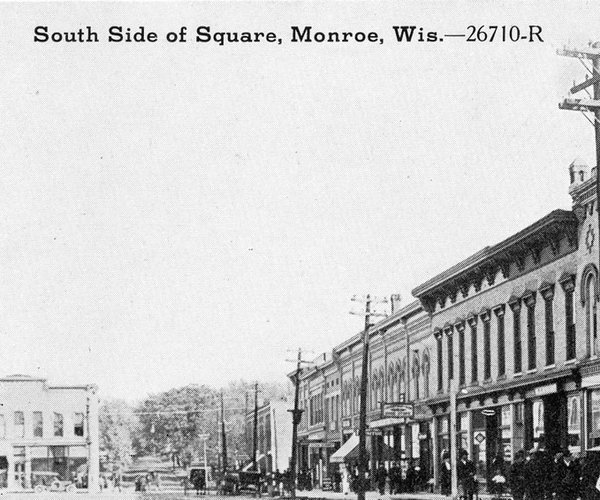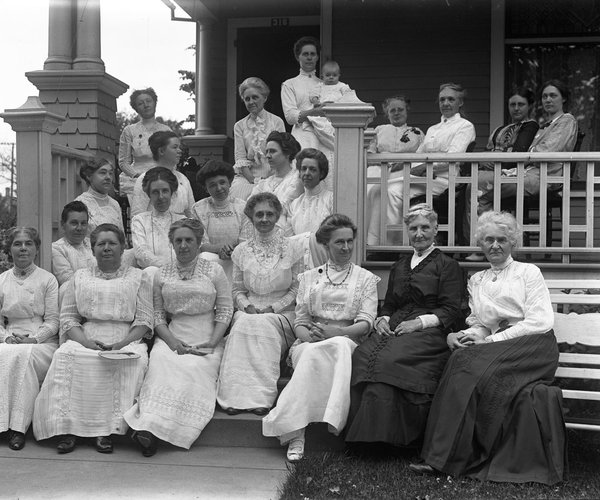“Shriner” has continuously been a part of the name of the funeral home or undertaking business in Monroe since the 1870s; Ferdinand Shriner, who was born in New Jersey in 1838, moved to Oneco, Illinois in 1854. He had been a cabinet maker and was farming with his father in Clarno Township in 1860; he then came to Monroe sometime after that and was involved in making furniture and coffins. The sale of burial boxes created a demand for the service of preparing bodies for burial. He worked in the business for the rest of his life. The name of the business changed several times through the decades with the Shriner family eventually becoming extinct from the business; the name is now Shriner-Hager-Gohlke Funeral Home.
It is unknown exactly when Shriner moved to Monroe, but he married Hannah Butts in 1867 and their son, Charles, was born the following year. His first employment in Monroe was as a cabinet maker for Blakely and Davenport, who dealt in furniture and coffins. The 1870 census shows that the family was living in Monroe where Ferdinand was working as a cabinet maker. At the time they had 2-year-old Charles and owned $600 of real estate and personal property worth $100. Their second son, Frank, was born in 1872. By 1875 the census showed three men and two women living in the home; the woman might have been a servant to help Hannah with the house and sons.
The first information I saw about Shriner in the Monroe papers was an alert to an advertisement in the January 14, 1874 issue of the Monroe Sentinel that said that Blakely & Shriner had “just added largely to their stock of furniture and are making and finishing all the time” at their “old established East Side Furniture Store.” The advertisement mentioned that it was a new year and a new firm with new prices. Besides furniture and upholstery goods, they also dealt with undertaking. Newell Blakely had been in business in Monroe for more than 20 years at that time. It is believed that Shriner had worked for the firm for several years prior to becoming a partner.
The first advertisement I found for them listed for “Undertaking” was three years later on March 7. It said that Blakely & Shriner were “the old and experienced firm” that had “the largest and best stock of undertakers goods in the country.” They were still located at Blakely’s Furniture Store and “ready to wait on customers for less money than any other firm in Monroe.” By January 1880 they had added a complete assortment of burial robes and shrouds to their stock of undertakers’ goods.
Shriner must have bought out Blakely in 1882; Blakely’s obituary said that he became a sheep farmer at this time. An article on June 18, 1884 said that Shriners’ undertaking business would occupy the building from which J. D. Mosher had recently removed his marble works. This building, located on the northeast corner of 17th Avenue and 10th Street, was being “put into good condition” at that time. Not much information was gleaned from the newspapers in those early years. One incident in November 1889 said that their hearse was in an accident that “resulted in the breaking of the plate glass panels and a spring;” it underwent repairs.
Ferdinand Shriner, who had “laid away many of our citizens,” passed away on March 9, 1893 at the age of 54, only two years after contracting the grippe [influenza]. “The deceased was full of sympathy for the suffering poor, and often laid them carefully to rest without a hope of reward here, but in the great future his reward will surely come.” Prior to his death, Ferdinand “made an earnest request of his sons, Charley and Frank, that they would continue the business that has been brought to such success by the energies of the father and the sons, and the business will be conducted at the old stand.” His obituary stated that he remained “Monroe’s only embalmer and undertaker until his death.” The County Journal added that the sons “are young men of exceptional ability and have been attentive assistants to their father for the last several years until they thoroughly understand the business and are perfectly competent to carry it on.” Frank was 21 at the time and Charley was four years older. Their mother would remain actively interested and guide them until her death in 1907. The business became known as Shriner Brothers.
Almost a year later on March 6, it was announced that the old stand of S. Miller & Son on the east side of the square (now 1018 17th Avenue and the home of Pancho & Lefty’s) was being renovated to become the undertaking parlors for Shriner Bros. They expected to make the move later that week, but were not able to do so until near the end of month because they had “attended twelve funerals within ten days.” They then operated their business in that building for the next 40 years.
Taking care of funerals was not easy in those days. An article on January 26, 1898 described a funeral where the Brothers had planned to go to Cadiz the day before to “take charge of the funeral of the late Mrs. Sarah Curtis,” who had died on Saturday. They were unable to get beyond Hawthorne’s, so they returned to Monroe. The storm was “terrific.”
More about the Shriner Brothers undertaking business on the east side of the square will be shared next week.
— Matt Figi is a Monroe resident and a local historian. His column will appear periodically on Saturdays in the Times. He can be reached at mfigi48@tds.net or at 608-325-6503.




